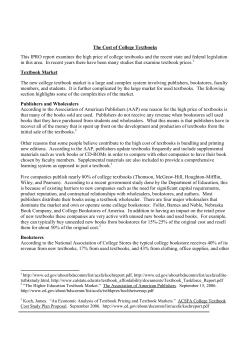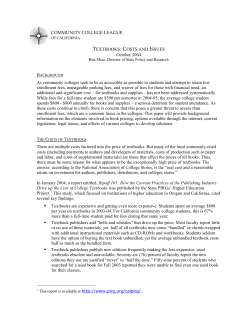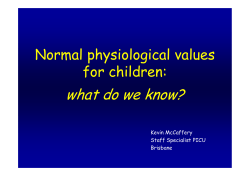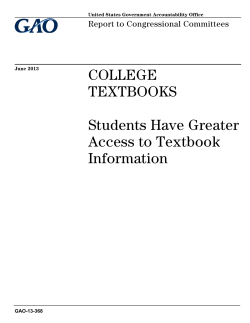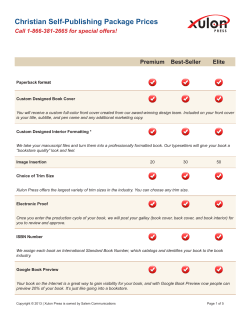
Why College Textbooks Cost So Much
Why College Textbooks Cost So Much Chapter Outline Ø The Process Ø Market Forms Ø Technology and the Impact of Used Books Ø When Price Does and Does Not Matter Chapter Objectives After reading this chapter you should be able to Ø Understand the process by which textbooks come to market. Ø Understand that there is competition among publishers such that depending on the subject, the models of monopoly, oligopoly, and monopolistic competition are appropriate. Ø Understand the impact that the internet has had on the used book market and how the used book market impacts the new book market. Ø Understand that the book selection process often doe not involve price. The market for college textbooks is a good example of a great many economic concepts: fixed and variable costs, the impact of patents and copyrights on the market for a good, the fuzziness of the line between oligopoly and monopolistic competition, and the degree to which increased technology increases supply. The Process Before we get too deep into the analysis you should understand how a textbook comes to market. In the beginning there is a void, or at least a perceived void. That is, either a publisher or a college professor decides that there is some niche not being adequately covered, some market share to gain with an alternative approach, or that all the books in the field are so poorly written that any improvement would garner great interest. This spawns the sample chapters. Either solicited or unsolicited, a faculty member will write a chapter or two to show a publisher why this new book would be better than those that exist. These sample chapters take a few months to write, refine and edit. When finished they are sent to the publisher. Very few of these make it past this step. Those sample chapters that meet with the publisher’s expectations are sent out to faculty who, when the book is published, might consider using the book for their course. Typically the publisher will pay four to eight selected faculty between $200 and $600 to read and comment on the book chapters. If the comments are positive, then a book is ready to be written. A contract is drawn up that specifies how the author is to be paid. Typically the author will get a percentage of the sales (in the neighborhood of 15%) to bookstores (based on the wholesale price net of returns.) An advance is usually offered to the author against future royalties. The book takes at least a year to write, revise, edit and publish. Often a first edition takes much longer as it is typically reviewed by a different collection of faculty around the country. 1 1 The first edition on this text was begun in 1999 and sold its first copy in 2002. Margin definitions Advance The amount of money paid to authors prior to a book’s publication. This is typically counted against future royalties. Royalties The amount of money paid to authors. Typically paid on a percentage basis. Once available for sale the book is mailed, free of charge, to faculty all around the country that teach a course in which the book might be used. This could be thousands of books, as is the case when there is a rollout of a Principles of Economics book (that which is appropriate for business and economics majors) or a few hundred (when the book has a more limited audience.) Faculty place their orders with their respective bookstores and the bookstores order them in the month leading up to the beginning of the semester. To see where the money goes on the sale of a new book, consider the one you are reading. As shown in Figure 41.1 the previous edition of this book sold for $80 as a new book in my university’s bookstore. The book was sold to the bookstore for $60 so its expenses and profit come out of their $20 markup. I get 15% of the amount that the publisher gets, or $9. The publisher keeps the remaining $51. The publisher’s costs include fixed costs such as the payments they have made for supplements (the testbank, the instructor’s manual, the web site material, the study guide, the Powerpoints, etc.), the share of the editorial staff’s time turning my work into its final form, and the share of the marketing staff’s time selling the book. The variable costs also include the cost of the paper, ink and printing of the book itself. Textbook paper is not cheap and, depending on whether the book is black and white, 2 color (which means black and white plus various shades of another color) or multicolor, the ink can be costly too. In all, the marginal production cost of a textbook is less than $10 sometimes as little as $5. When all is said and done the $51 margin that the publisher makes must cover all of the fixed costs of production. Bookstore Markup $20 Publisher Fixed Expenses, and Profit $41-$46 $80 Ink, Paper, Printing Cost $5-$10 Author Royalty $9 Figure 41.1 Where the money goes Here it gets tricky because the publisher, and by extension the author, only makes money when a new book is sold. You do not have to be in college very long to know that you can buy used textbooks for much less than new ones and that you can sell your books back to the bookstore at the end of the semester. Typically a book that sells new for $80 will sell used for $60. The bookstore will have purchased that used book from a previous student for around $40. The bookstore then stocks both new books and used books and makes a profit on either. There is some risk for the bookstore in overstocking a new book since they have to pay a restocking fee to return new books to the publisher but there is enormous risk overstocking used books. This is because if there is a new edition of the book, the old edition is worthless. This brings us to the new-edition scam. Calculus hasn’t changed since Newton figured it out so why would anyone need to write a new edition? Because publishers and authors only make money when the new edition sells for the first time. Publication cycles typically run for two to four years between editions. Who’s to blame for all this. Everybody….including your professors. Faculty, especially those that teach large classes, want a testbank (a computer generated set of questions they can ask on multiple choice tests.) They want these tests to have a mix of easy and hard questions and they want the questions to have only one good answer. That costs money. Second, remember that your faculty member got the book for free. His or her office is either full of textbooks (some with the wrapper still on them), or he or she has either given them away or sold them. Suppose Professor X writes a new book and Professor Y uses it but Professor Z does not. Professor X makes money on the royalties but Professor Z also makes money by selling the free copy. This is one of those things that you see all the time but you may not recognize. Textbook buyers will walk the halls of faculty office buildings looking to buy sample copies from faculty. They will themselves resell them online and at regular college textbook stores. Your $80 book may have been purchased by a bookbuyer for $28 from a faculty member, sold to a textbook wholesaler for $35 and then sold to a bookstore for $50. Finally, you by it for $60. When a book is sold this way the author gets nothing. Figure 41.2 below illustrates this recycling of textbooks. Note that the only time the publisher or the author make money is shown in the upper left hand corner: when the bookstore buys the book from the publisher. In every other transaction noted here, someone else is making money. Publisher sells to the university bookstore for $60 Given to faculty member for free If the faculty member wants to (s)he can sell it to a book buyer. Bookstore buys used books that other schools and book buyers have sent to MBS. Faculty member sells the free sample for $28 Textbook wholesaler pays $35 New book is sold to a student for $80, used for $60 Bookstore may sell book to MBS if it will not be used at school the next semester for $20 Student sells book back to their own bookstore. If the book will be used at the school the next semester they get $40 if it was bought new; $30 if it was bought used. If the book is not going to be used next semester, the bookstore may not buy it back. If it does buy the book back it will be for a deep discount. Textbook wholesaler (MBS) collects and sorts books to be sold back to bookstores. Figure 41.2 The textbook recycling process Alas, you are also to blame. You want your professors to teach from books with wellarticulated websites, from books that have study guides, and from books that have Powerpoints. These ancillaries cost serious money to produce. The ancillaries budget for a new book depends significantly on the number of books the publisher believes can be sold. A book like the one you are reading has a budget of between $15,000 and $20,000 depending on how much work needs to be done. The bottom line for publishers is that they are in business to make money. The breakeven point on a book such as this one is around 7,000 units. We can use basic math to figure the how the bottom line is affected by sales. This is done in Table 41.1. Increasing sales adds quickly to the bottom line because for each book sold, there are only $14 in costs and $60 in revenue. Table 41.1 A simple analysis of textbook profitability Economic Concept Revenue Fixed Costs Variable Costs Profit Detail Price to the bookstore x Number of books sold Payment for Ancillaries (Powerpoint, Web, Testbank, Instructor’s Manual, Study Guide) Editing, Typesetting, Graphics, Payment for Reviews, Marketing Royalties Materials Revenue – Fixed Costs – Variable Costs Assuming Breakeven Assuming Sales of Sales of 7,000 units @$60 15,000 units @ $60 $420,000 $900,000 $20,000 $20,000 $300,000 $300,000 $65,000 $35,000 $0 $135,000 $75,000 $370,000 The book you are reading is the intellectual property of its owner. I gave that intellectual property to the publisher in exchange for the royalties they pay me for sales on the book. What the copyright does is it gives McGraw-Hill the exclusive right to sell this material. It also prohibits you from walking down to Kinko’s and running off copies for your friends. Copyrights are necessary to bring intellectual property to market because without them producers of the books, songs, and inventions would have no financial motivation to do so. 2 Textbooks and Market Forms In some disciplines there is one standard textbook that everyone uses while in others there are multiple texts that look very much the same. In this section we will use the market for economics textbooks to illustrate some of these market form concepts and learn why college texts have risen in price so greatly. Once you understand the structure of the textbook market it becomes easier to see why they cost so much. There are hundreds of textbooks on the market but most are not good 2 A copyright lasts for a long period of time, 95 years after publication or 70 years after the death of the creator, which ever is longer. Chances are quite good that no one will be interested in this book at that time. On the other hand you can pick up a copy of Marx’s Das Kapital or Adam Smith’s The Wealth of Nations for less than $10 because the copyright has expired and the book is in the public domain. substitutes for another. It does little good to bring your economics text to your poetry class. In the end, your professor probably had a relatively small number of books from which to choose. If you are using this book while taking a general education economics course for nonmajors, your professor had to decide whether to cram a bunch of theory in or do an issues approach. Having chosen this book your professor chose the issues approach. There are four books that really work in this niche. I, or more properly, McGraw-Hill has a monopoly on this book but it is a competitor in this area. The market form best suited to this area is monopolistic competition. The market for Principles of Economics texts is much greater and there are many more choices. There are four really big sellers and several scattered players. This is also an example of monopolistic competition. The differences between books is quite slight (mostly in presentation and emphasis) but the publishers still retain their monopoly rights. For an example of an area in which there are fewer sellers, consider the market for graduate level textbooks in mathematical economics. For all intents and purposes, there are two. One has been around since dirt and the other one is a few years old. This is an example of oligopoly. Some areas of economics are so narrow, with such a small market that there is only one book. In Table 41.2 below the number of books that exist for specific economics courses are listed, along with the range of new price. Table 41.2 The market for common economics textbooks Discipline Number of Lowest Highest Books Price Price 23 80.51 103.55 23 107.30 133.00 Essentials (General Education) Principles (Combined Macro and Micro) Principles of Macroeconomics 23 87.35 97.95 Principles of Microeconomics 23 87.35 97.95 Intermediate Macroeconomics 15 90.25 129.20 Intermediate Microeconomics 15 115.85 126.35 International Economics* 17 96.71 123.95 Money and Banking 7 101.33 119.13 Mathematical Economics* 10 99.95 126.35 Econometrics* 28 96.85 126.35 Labor Economics 6 112.81 121.55 Public Finance 4 116.80 121.55 * Includes books that are billed as meeting the needs of “advanced undergraduates and graduate students.” Source: http://barnesandnoble.com Technology and the Impact of Used Books Consider the predicament of a college student without a robust used book wholesale market. A student at the University of Florida may have purchased this book in August only to discover in December that because the faculty member using it was moving to a different school, the book would not be used on that campus again. That student’s bookstore would be reluctant to buy the book back because they would have no assurance that the book would be used again at the University of Florida. Now suppose that same faculty member adopts the book in the Spring at the University of Washington. Those students would be stuck buying a new version of the book because the student with the perfectly good used book to sell does not know about the student looking for a book to buy. Technology bridges that information gap. Computers, computer networks, and, more recently the internet, have allowed the two students to meet up through textbook buyers and the used textbook wholesalers. Today a textbook is easily recycled throughout the system and throughout the publication cycle of the book. The turnaround time from December to January is now the only bottleneck. Those with books to sell can find buyers quickly and easily using either direct locating web sites (like eBay) or through internet buyers and sellers (like textbookbuyers.com). Though the internet has significantly increased the availability of used books, it has also contributed to the increased cost of new ones. Remember that the publisher and author will only produce the book if they are sufficiently compensated. The technologyenhanced used book market has cut into sales of new books by increasing the rate of reuse. The result is that publishers have to raise the new book price and to shorten (sometimes artificially) the publication cycle for new editions in order to make money for themselves and to compensate authors. When Price Matters and When it Does Not When you buy a car, go to a restaurant, go shopping, or take a trip you consider price because you are the one making the decision. Textbooks are chosen for you and by a faculty member who is often completely oblivious to the price that will be charged for the book. Faculty get the book for free and rarely inquire as to the price that will be charged. When students go to the bookstore and get their books they cannot chose which book to buy (beyond their choice of used versus new), they have to decide to buy the book or not. Thus the price of the book is irrelevant in the adoption decision. Under good circumstances the adoption decision is typically made after a professor has looked at the choices in the area and selected the one that goes best with the course and the way the professor teaches. In the end, faculty often pick books that have the supplements they are looking for, have illustrations that simplify the subject, and are pleasing to the eye. All of these add to the price of the book but the price simply does not enter into the decision to adopt the book. The student is then made to choose between buying the book and not. Faculty consider buying the book the first real test of whether students are serious about their course. When students ask questions and the professor indicates that the answers can be found in the book, if the students indicates they did not buy the book, professors are typically unsympathetic. So Why Do They Cost So Much and Who’s to Blame? Taken together, the reasons listed above give rise to very expensive books. Faculty take time to write them on the premise that they will be rewarded. They take an enormous amount of time and money to write, edit and publish. The supplements necessary to generate adoptions are expensive to create. The fact that only the first sale generates revenue for the publisher and royalties for the author means that new editions have to be regularly produced. In some areas, books are expensive because there is little or no competition. Finally, professors choose to adopt textbooks and rarely think about textbook prices in the process. The student is given a take it or leave it option. In every case each person, each entity makes a seemingly simple economic calculation and acts in their own interest. An author decides whether or not to take the time to write a book based on what they view as a reasonable expectation of compensation. Faculty pick the books they think will work best for their courses and students. Publishers work with authors to put the best (“best” here means most marketable) book they can on the shelves. Bookstores stock the books that faculty indicate they are requiring for their courses. Students try to buy books as cheaply as possible. Add in book buyers and wholesalers realizing that there is money to be made by buying up unwanted books and getting them to where they are wanted and you have a recipe for the conclusion that “the free market is to blame.” In the end the problem of textbook prices is the same as the problem for prescription drug companies: enormously high fixed costs and very low variable costs. Compound that with the similarity to the music industry and imagine a world where pirated textbooks could be downloaded in PDF form for free? The market for textbooks is undergoing enormous change and by the time you send your children to college, the textbook may be as quaint as the vinyl LP and 8-track tape. The content will still be important but it may not come to you on paper. Summary You now understand why this particular textbook cost you as much as it did. You understand the process by which a book comes to the market and the high fixed cost- low marginal cost aspect of the industry. You understand that the market form that governs a particular textbook can vary from monopolistic competition to oligopoly to monopoly. Finally, you understand the importance of the used textbook market and how it affects new book production cycles and costs. Quiz Yourself 1. In a course like Principles of Economics (Macro, Micro or combined) the market form for textbooks is a) monopoly. b) oligopoly. c) monopolistic competition. d) perfect competition. 2. The textbook production industry has a great deal in common with the pharmaceutical industry in that there are _____ fixed costs and ____ marginal costs. a) high; high b) high; low c) low; high d) low; low 3. Authors are typically paid for their work a) based on a percentage of the sales at college bookstores. b) based on a percentage of the sales from publishers to bookstores. c) a fixed rate. d) on a per page basis. 4. Which of the following make no money in the system that buys and sells used books. a) publishers b) textbook buyers c) textbook resellers d) bookstores 5. The buying and selling of used textbooks has been around since the 1920s. This market has been more active recently thanks to a) cell phones. b) bookstores. c) publishers. d) the internet. 6. The typical $100 college textbook will net the author _____ in royalties. a) $5 b) $12 c) $25 d) $50 Think About This Imagine yourself in the position of a professional where it was common practice to send goods to you unsolicited. Imagine further that the reason they did this was so that you would recommend their purchase by the people with whom you deal. Also imagine that you were legally entitled to sell the sample goods and that there was a market for them. Would you sell them? Talk About This Some instructors are told by their department chair (or a committee) which book they have to use. Ask your instructor if they had a choice. Ask him/her if (s)he knows how much you paid for this book. Ask them if the process for textbook choice for this course considered price.
© Copyright 2025


![Running Head: [insert running head here]](http://cdn1.abcdocz.com/store/data/000717351_1-f1214ea45296ad760248d9c8c5d9fdfe-250x500.png)
